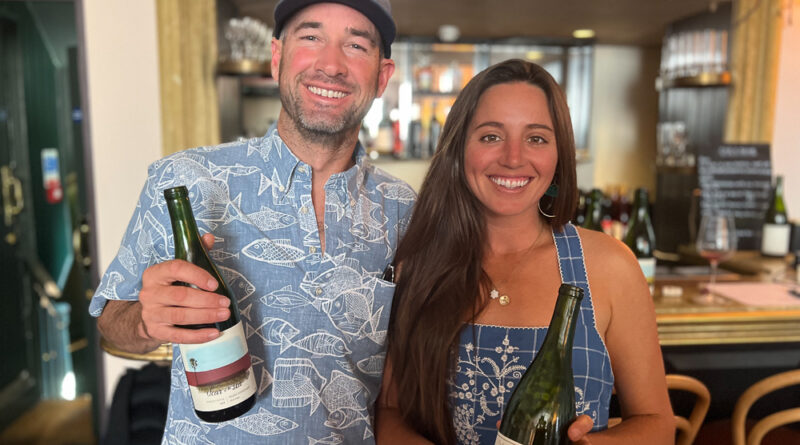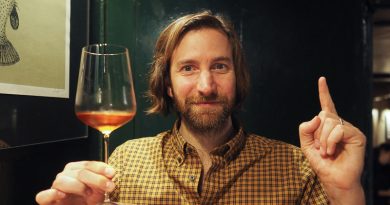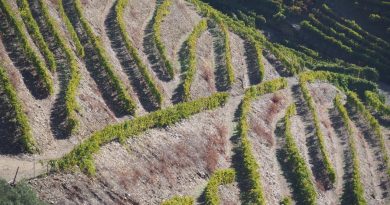Scar of the Sea and Lady of the Sunshine: Mikey and Gina Giugni talk farming and present their wines
https://www.scaroftheseawines.com/
https://www.ladyofthesunshinewines.com/
I caught up with Gina and Mikey Giugni in London, to hear about their farming and try their wines. They have a brand each. Scar of the Sea is Mikey’s, and Lady of the Sunshine is Gina’s. ‘Gina and I started our wineries at separate times,’ says Mikey, ‘and later we married and combined our wineries under one roof. We share many an ethos as for how to grow grapes and how to make wines, but we were trained differently, a lot like chefs trained in different kitchens. Farming is very much a trade that you pick up as you go, and it is imprinted by the people that you work with. Even though we have very similar ideas, and even wines that we like, we make decisions very differently. This allows us to stay happily married. We can honour each other’s decisions.’
‘We can be each other’s sound board because we have this understanding of what we value. But then it is very much an expression of our personalities,’ says Gina.
They have two vineyards. Chene vineyard is a 6.5 acre vineyard in the Edna Valley that they’ve been farming since 2018, and Mountain Meadow is 4 acres of Pinot Noir in the San Luis Obispo Coast. They described the way they farm, which includes biodynamic and regenerative approaches.
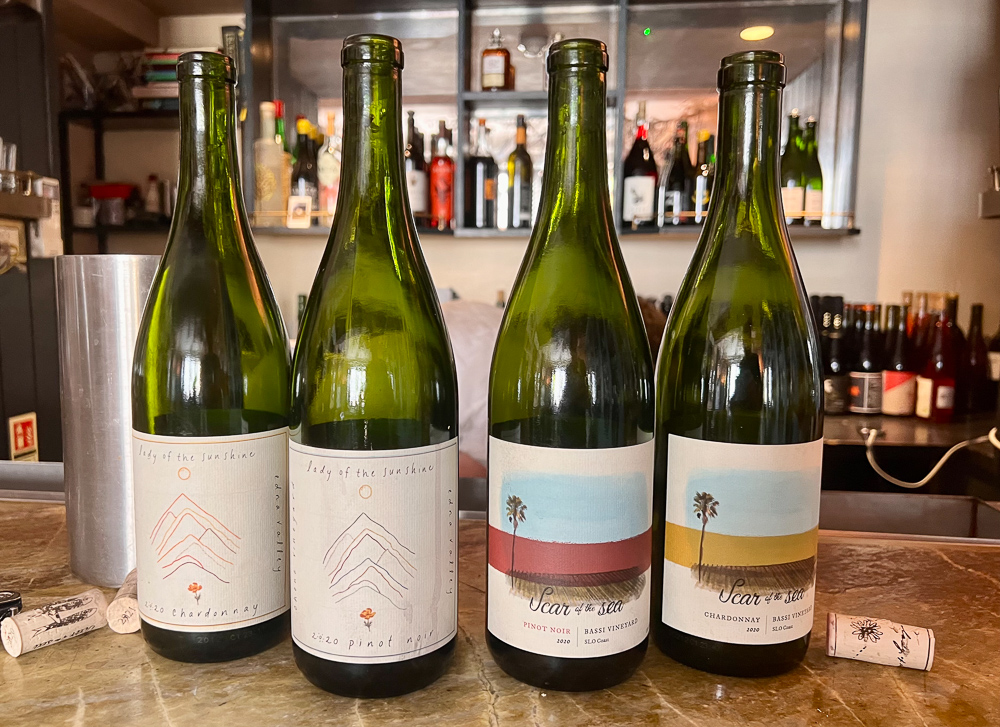
Gina: The soil is the stomach of the farm. How can we build immunity in the farm, through biodiversity and soil health? We can build resiliency: that is the goal. We are farming in a dramatic climate in California. We are a little bit more insulated on the coast, because we are closer to the ocean. The whole point in making transparent wines to reflect our farming approach is to build resiliency towards climate change.
Mike: Gina grew up on a biodynamic ranch in the Sierra Foothills. Frank [Hildebrand, Narrow Gate Vineyards] has been farming with biodynamics since 2008. He has been a big coach for us: he has been a mentor for us in getting started. We are lucky because there are not that many farmers in California with this mindset. Farming like this isn’t like farming with a textbook. It is all dependent on where you are at. How we make compost teas, how we make compost and how we deal with our land is slightly different from some of our best friends, who have the same philosophy but they do it slightly differently, because they have a slightly different climate.
Gina: The Chene vineyard is 6.5 acres, so it’s quite small, but it very much feels like our own island within the Edna Valley AVA. We are in the southwest pocket of the valley, which sits 4 miles inland from the Pacific. There is a small ridge that blocks off the main ocean weather that would come from the west, but since the valley runs north to south our biggest wind gap comes from the north, from a small coastal town called Moro Bay. We get the marine layer that drifts over that ridge to the west and blankets the whole valley with fog. It’s not until you have that pressure gradient that switches on early on in the afternoon that it starts to warm up, where the wind blows in from the north and blows out the fog.
Mikey: It is like a big swamp cooler. The Pacific is always cold: you don’t go surfing without a westsuit. The wind is blowing across the cold ocean and then it is coming into the valley. It happens about 1 pm and so the warmest part of the day is 11 am. The fog comes over and is there all morning until 9-10 am, and gets burned off before the winds come. Then the sun is out and it’s hot, and then in early afternoon the breeze comes. The soil at Chene is unique: it is a diataomaceous earth, a white, chalky, light rock. It looks heavy, but it is like chalk. You can taste this in Gina’s wines: her Chardonnay and Pinot have a lot of edges. The soil, because it is so think, makes these wines that are less fruity and rounded, and more edgy and tight.
Gina: I bring up the orientation of the valley and the proximity to the ocean because our greatest challenge working with biodynamics is that we have such high mildew pressure. Because we are under fog we have high humidity, and our coastal daytime temperature is in the 70s F. It is everything that mildew loves to be around. We have found a great product that has been recommended by my father, which is a cinnamon oil base. To combat powdery mildew, there are two main kinds of sprays. There are those that are topical, something that sticks to the leaves. Cinnamon oil is a great medium. Just like you are cooking and have olive oil on your hands and then go to rinse it in the sink, it takes a few washes to get the oil off. Coating the canopy and clusters that are forming in an oil base keeps the mildew spores from being able to stick. Then you have the fog that starts to dilute it each day it passes, so you have to reapply it quite often. The other beauty about cinnamon oil is that it is extremely mild for beneficial insects. You can spray it and re-enter the vineyard, and it smells nice! The opposite side of the spectrum is spraying the vineyard with a systemic. Instead of having a topical approach, the systemic gets absorbed by the vine and fights the mildew from the inside out. So you can have a longer time interval between sprays. But it can be quite harsh on the environment. It’s synthetically made, so there are consequences with that choice. The powdery mildew is our biggest challenge.
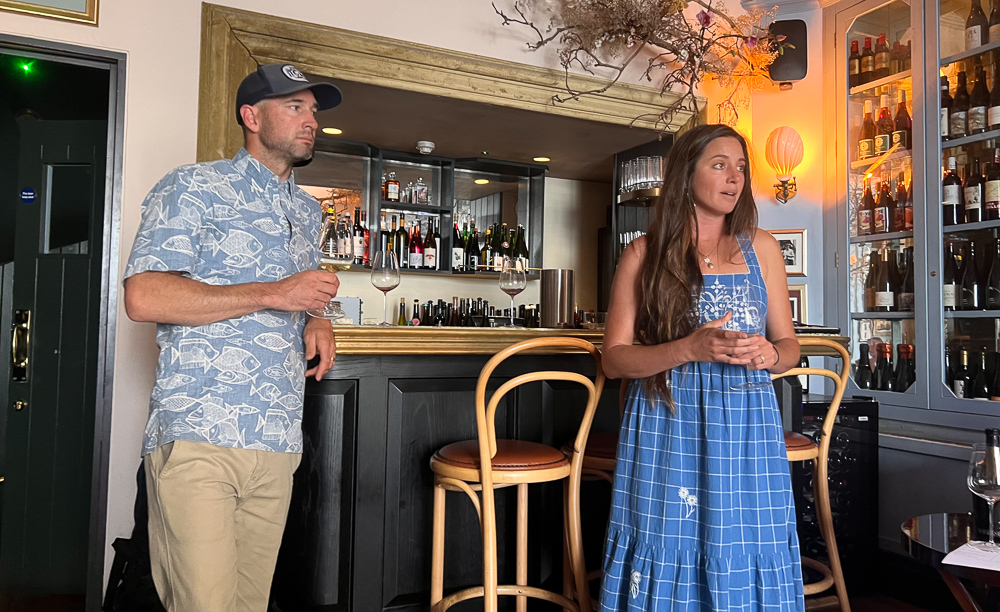
Mikey: A natural farmer watches the weather very seriously, because the weather is everything. Understanding what temperatures mildew thrives in, what the wind is doing, also have you opened your canopy, so the canopy is not congested. The biggest jobs for us in the early farming season are pruning, selecting what canopy we are going to have, and then shoot thinning, selecting from our selection which green tissues we want to grow. This allows us to manage our crop, manage next years pruning, and manage the airflow and the sunlight. These are our natural deterrents to mildew. These are key. Then it is managing how they grow, so we have different types of trellising in the two vineyards we farm.
Gina: When I start trading farming stories with my father and our different experiences, there is something that really stands out. My father gets snow because he is in a continental climate. He has a harsh winter, and that supresses his weed pressure. Everything gets suppressed in the winter time because they have a hard frost. But we are on the coast, and weeds grow year round. There is no off season for weeds. This is a challenge. We have a lot of really tall grasses that are non-native to California. Cover cropping has been huge, trying to build up the seed bank with beneficial plants, lower lying plants like different types of clovers.
Mikey: Another thing is changing your perspective. It is hard for humans to not control everything, and understand what nature looks like. Our vineyard is messy. If you were to walk through our vineyard, there are a lot of weeds. It is not chaos, because we want some sort of organization. There’s a balance, and this year has been extremely hard for farming because we had so much rain. Because of this, the ground took a lot of water. Then it stopped raining and we thought a month later we should be able to get the tractors in to start to organize our chaos, but the ground was still seeping water – it was still wet. We weren’t able to get the tractors in to mow and deal with under-vine weeds for a long time.
Gina: I had cover crop as tall as me!
Mikey: That’s fine, except for timing. Then it’s frost risk and budbreak, and we want the air to be able to flow. We had a weed called vetch, which is a great weed, and it fixes nitrogen, but this year it was growing over the vines. It’s a crawler. And the vines were starting to wake up. We were literally pulling the vetch off the vines by hand.
Gina: Everything is about balance. It is not about eliminating anything: we need the checks and balances. It’s OK for there to be invasive weeds, and it’s OK for us to plant our cover crops. It is OK to have pests, but you also need the beneficial insects. When you create a system that has biodiversity, the good and bad can survive together, and they keep each other in check. We are just in charge of finding where that balance lies.
Mikey: The Chene vineyard looks like Gina has lots of flowers and it is messy and fun. We are excited to go back to see what it looks like after 10 days away. The other vineyard we farm is called Mountain Meadow, and it is in the mountains above Cambria and Cayucos. It sits at about 1600 feet, and it is also Pinot Noir. One important point is that we haven’t planted the vineyards that we are working with. We lease the lands. I can’t say we wouldn’t like to own vineyards; it’s just not the means that we have. These are both vineyards that we have kind of inherited. Would we plant Pinot in these spots? Probably not. But are we happy to farm them and make it? 100%.
Gina: The true testimony of our style of farming has been the yields. At the end of the day, you farming needs to be sustainable not just for the land, but financially. We are negociants too: we farm a percentage of our fruit and we also buy from friends who share the same farming philosophy as us. In a lot of other vineyards we are working with in 2022 we saw a 50% reduction of yields. We were at the end of a few years of drought and the vineyards just weren’t producing to the yields they had been in the past. This shocked the system. At Chene, we saw a reduction from 3 tons/acre to 2.5 tons/acre, and it wasn’t 50%. It was a small shift; there was this resiliency in yields.
Mikey: In California there are techniques we are using that we are not seeing in France. We are not trying to strip the leaves in our fruit zone. We are looking for shade. There will be crop loss in July when the first heat wave comes and you will see raisining. In our vineyard when we have seen it, it is on the morning side at 10 or 11 am, and it just got really hot. In 2020 we saw a 20% loss from a July heatwave. We are scared of the September heatwaves in California because they define our vintages. 2020 was defined by a Labor Day heatwave (the first holiday in September). Also, 2022 was defined by that same heatwave. This vintage will be interesting: because we are so much later, we won’t be getting the option to choose to pick before or after this heatwave. The grapes won’t be ready by Labor Day, so everyone will wear that heatwave. In the past ones, they were early vintages. Because of our style and how we don’t fertilize and over-irrigate these vineyards, they were ready before the heatwave. We were able to make our same style wine. This year will be different. Also, fires – we can’t say we are immune to fires. Smoke taint is a real concern. This is also why as a California farmer I like picking early. I have nothing against picking in early September or August. My odds of making a sound wine are much higher: I am not dealing with the multiple heatwaves and fires. As viticulture progresses in California I would imagine more and more people are going to be wanting to plant things that ripen on the early side. It is easier and safer. The most important decision that we make is when to pick the grapes. For us, especially, because we are not willing to change the chemistry of the grape must, that decision is crucial. It gives us a lot of anxiety. For us it is chemistry (sampling the vineyard and looking at pH, TA and Brix) and it is also taste. And it is visual. Is the canopy ready? Are the vines going through senescence? Does it look like fall is starting to happen here? This is telling you a lot about what is happening to the grapes.
Gina: Do we have lignification of shoots and the stems of the clusters? Are the vines dropping their basal leaves?
Mikey: For Chardonnay in particular, it is what the grapes look like. How see through are they? It’s the taste and texture: how does the pulp release from the seeds and what is the colour of the seeds? Every variety is different, and even every vineyard differs in what you expect from it. You start to learn sites. And it is a combination of these factors and the weather. We sample a lot; we do it ourselves. Early on we might have people sample for us to establish a baseline, but when you get to a certain spot I need to see with my eyes and taste.
Gina: We also learn from the past.
Mikey: There are also the logistical challenges of winemaking. It is all about logistics. A good wine producer is a solid logistics manager. In California many of us rely on labour contractors to help us. This means there is a long list, when things are ready. The earlier you are in your projections, and if you know how to work with people and pay people, all this makes a huge difference. By being a good partner you are more likely to be able to get the help you need when you need it. By planning and sampling thoroughly we have been fortunate to not be left hanging when we really need to pick grapes.
What about composting?
Gina: We are very much farming the soils and not the vines. We are not putting compost under the vines. Most of our attention is farming the soil, in the vine row.
Mikey: When we put compost down we are not feeding a vine. We are very lofi. We make around 30 tons of compost a year, made of our pomace, cow manure and wood chip waste. This will be manually shovelled out of picking bins as we drive a tractor. Our vineyard is side sloped and steep we can’t tow a trailer behind us.
Gina: The farm is one body. We have 12 000 vines in the soil and we view these as 12 000 dots that all connect into one big body. This is why we are not feeding the vines. They are held in the unity of the farm. We are believers in the microbial terroir. It is the health and the heartbeat of the farm.
Mikey: It is also the energy in the wine. We have seen vineyards that improve their biodiversity and their soil health, and there is more energy in the wine as the vineyard becomes more alive.
Gina: We make compost year round. The beginning of the process is at harvest time. We take all of our pressings from the winery and transport it to the vineyard, and that becomes the basis of the compost. The cow manure comes from the farm across the street where there is a 30 acre pasture, with a head of cows. We go over with a bucket and a shovel. We are looking for the compost pile to be 30-40% cow manure, and then 60% pomace, and whatever else we can collect from the property in terms of green waste.
Mikey: We collect our lees at the winery because they are bad for waste water. They are high in nitrogen. We put them in barrels, settle them again, use the wine for topping, then we will use the lees in the compost.
Gina: We insulate it with hay clippings, to trap in as much moisture and heat as we can.
Mikey: Compost making is even more complex than winemaking. There are a lot of different methods. We monitor the temperature: a lot of it is how big you make the pile and how much rain you have.
Gina: if it goes above 140 or 150 F, you open it up and aerate it, and put it back together.
Mikey: In 2018 when we started we made a small amount of compost. It is a lot of work. We made about 5 tons as a project, and we purchased 20 tons of organic compost. When we were spreading it the purchased compost was clearly not great. It was very dry, with lots of microplastics. We did our load and it was like black gold. Rich, dark and fluffy: all the textures you want. This is when we realised we had to make our own, and maybe we don’t need to put out the levels that people tell you.
Gina: We also do a series of different compost teas, microdosing the vineyard with an inoculum of good bacteria and microbes that you want to infuse the soil with. The compost isn’t so much about trying to fix the nitrogen levels in our soils, because they are very unfertile, but it is this maintenance approach.
Mikey: We made a mistake in the beginning of not checking our organic matter and having a baseline. It is hard to know the progress we have made, but I can tell you the visual progress. When we inherited this vineyard it was full of mustard and all these lame weeds that were not doing what we wanted. Now when you walk through the vineyard it is full of lots of sorts of grasses, legumes and flowers.
Gina: We wait until the winter rains, and we spread the compost every other row. Then we come through and have a light disc. We are trying to incorporate the compost into the humus layer in the top soil.
Mikey: It is like a three inch/four inch disc. We have trialled no discing versus every other row: the most discing we do is every other row. This switches each year. Anything we disc we then follow up with a seed drill of cover crops. There is never bare earth for very long.
THE WINES
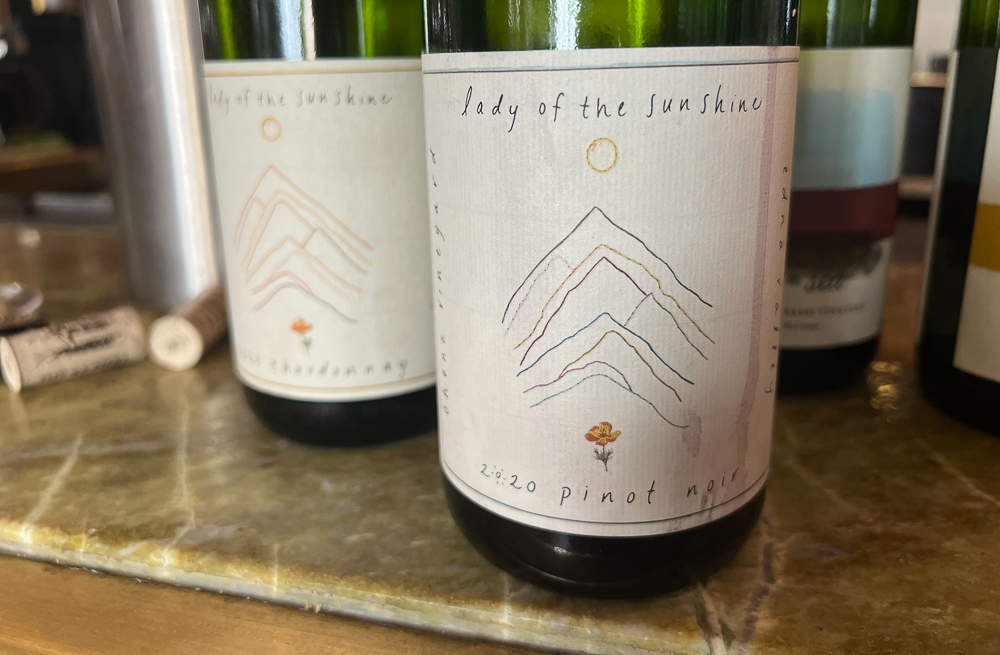
Lady of the Sunshine Chene Vineyard Chardonnay 2020 Edna Valley, California
This is a 6.5 acre vineyard with a bedrock of diatomaceous earth, and a top soil that can be very sandy. There are steep slopes here. Delicate, refined aromatics of pear, white peach and chamomile, with some stony notes. The palate is linear and focused with more of these stony notes as well as fine citrus fruit, beautifully layered with focus and refinement. Fine grained with some subtle mealy notes. 95/100
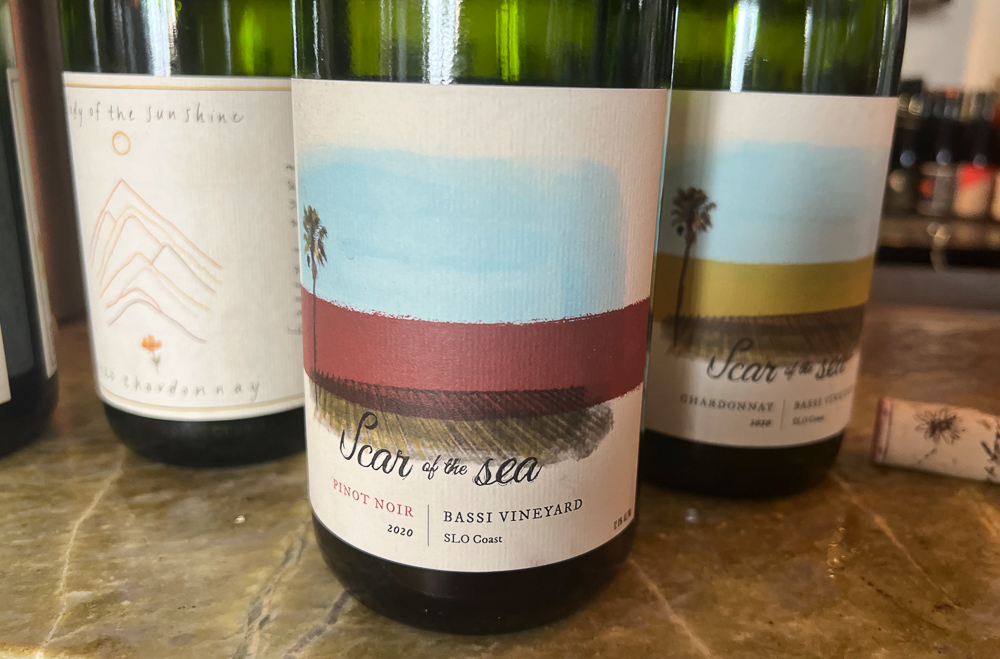
Scar of the Sea Bassi Vineyard Chardonnay 2020 SLO Coast, California
This is a 30 acre vineyard planted in the late 1990s, organic from the start. There are no wind gaps even though this is just 1 mile from the beach, so it’s a warmer site than Chene. 5-10% of this is from a solera. Distinctive aromatics: mealy and toasty with some popcorn and a touch of apple. The palate is powerful and intense, focused and mineral with lovely spicy detail. Intense citrus fruit with great acidity. Spicy and lively with immense structure and acidity. Electric. The nose is quite different to the palate. 95/100
Lady of the Sunshine Chene Vineyard Pinot Noir 2020 Edna Valley, California
100% whole cluster. Dijon clones yielding 3 tons/acre, harvested at 21.5/22 Brix. Sweet aromatics: delicate and fine with red cherries and a hint of tea. The palate is elegant, fine, sappy and detailed with amazing finesse and direct raspberry and cherry fruit, with fine-grained structure. Really fine. 96/100
Scar of the Sea Bassi Vineyard Pinot Noir 2020 SLO Coast, California
40% whole bunch. Lovely depth and concentration here with some green notes alongside raspberry and cherry fruit. Bold and intense with good structure and acidity. Rich with nice concentration and powerful fruity flavours. Lots going on here: has amazing vitality. 95/100
UK agent: Indigo Wine
Find these wines with wine-searcher.com

